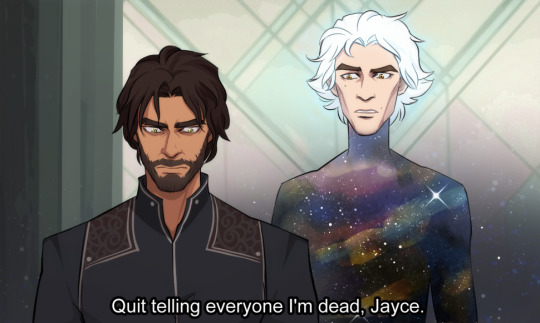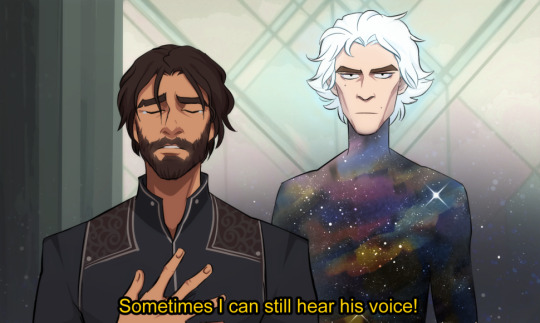Text
Brigador and the Art of Sky-High Storytelling
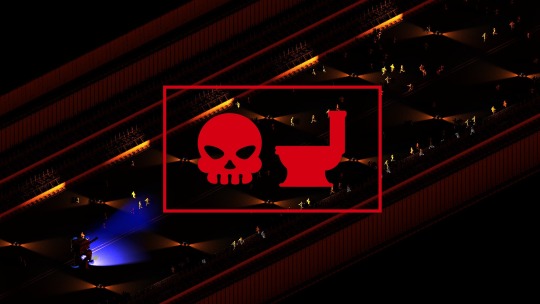
“GREAT LEADER IS DEAD. SOLO NOBRE MUST FALL.”
The first spoken words of Brigador, synthesised through a muffled speaker and emblazoned on-screen in bold, unadorned, searing red letters, are all the exposition it strictly needs: it is a time of great upheaval on the frontier colony of Solo Nobre, and you, with your ten-ton armoured mercenary mech, are here to do some heaving. Narrative and lore are strictly confined to downtime; to dense slabs of text filed neatly away in the codex, to be optionally purchased and read at one’s leisure. There’s no place in the combat for direct storytelling, between the rumbling of diesel engines and the whip-crack of electromagnetic slugs, and even if there was, it’d be little more than poorly embellished justifications for “go here, destroy those buildings, go there, destroy those units, leave.”
But to dismiss Brigador as pure context-free action is to fail to recognise how it speaks. When we think of environmental storytelling, we think small. We think of unconvincing graffiti on crumbling walls, half-finished meals, abandoned chess boards, desks piled high with papers, carefully-placed bookmarks, downed tools and barricaded doors. We think of skeletons in compromising poses, and trails of blood that laugh in the face of a bucket of bleach. Personal stories are made when people leave personal imprints, as taken to extremes by, say, Fullbright’s shtick of giving you a whole night to rummage through your family’s household belongings unfettered. For this very reason, the most popular examples of experiences with environmental storytelling are largely those that enable you to get up close and pick it apart, preferably without being too rushed. There’s a special kind of intimacy in it, almost voyeuristic, as you sift through the documents of a person who would certainly have objected to your intrusion if they weren’t lying slumped against a nearby desk with an alien birthing cavity where their guts used to be.

Brigador is the antithesis of that. Its sky-high isometric viewpoint, panning silently over the streets, gives you little such insight into the fine details. You can’t tell the story of a person from up here—at least, not easily—but you can tell the stories of people. And war is all about people, collectively; people fighting, people fleeing, people dying. Stories of lone figures, unless they hold huge power or significance, are swept away in the tide of shared tales, told through numbers rather than poignant letters to mother. You can pluck lone individuals out, humanise them and piece together their fate, but chances are that they were just one of a hundred, or a thousand, or a million people in the same boat, going through the same motions. Those collective motions, and their collective effects, are the ones that Brigador’s environments make us privy to.
One major target objective recurs through your missions: the orbital guns. Solo Nobre’s surface bristles with these skyward-pointed cannons, designed to obliterate any spacefaring aid that so much as entertains the thought of helping liberate the colony. Naturally, they’ve got to go, but it’s the way they impose on their surroundings, irrespective of context, that fascinates me. Taller than a city block, frequently ringed by sheer defensive walls and expanses of flat asphalt, their incongruousness isn’t just stark; it’s deliberately exaggerated. They invade the space around them, like alien landing craft, making no effort to compromise or integrate no matter where they are. To us, the player, they drive home the extent to which recent rampant militarization has dominated the lives of Solo Nobre’s people. What’s it like to have one of those things in your back yard? On your block? In your cemetery? Looming threateningly, a permanent reminder that the entire colony was, and is, ruled through military force. It’s all too easy to imagine them just springing up one night in a flurry of jackbooted activity, confusing and unnerving locals who understand nothing of the political situation, only that they’re now the unwilling neighbours of the biggest, juiciest, most explosive target in the district.

Most of Solo Nobre looks as if it sprung up overnight, to be honest. Many of the maps have a decidedly frontier air to them, sharply contrasting undeveloped wastelands with industrial and agricultural estates—or outright shanty towns, on occasion—and even developed zones are often distinctly utilitarian, as if the first construction efforts focused solely on establishing the functional basics and nobody’s had a chance to do a second pass. Why is that important? Because it means that whatever worldly influences went into the colony’s initial construction—the decisions, the constraints, the goals—are still relevant. Spaces change meaning over time; they get repurposed, recontextualised, rebuilt, and in the process the original intent of their structure gets muddled. Solo Nobre hasn’t had a chance to get especially muddled yet: everything on the landscape feels as if it has a current, relevant reason to be there. The story of the colony is coded into its infrastructure, fresh as the first coat of gunmetal-grey paint. Roads, buildings, fences, zones.
And wouldn’t you know it? That’s the part that you, with the omnipotent eyes of a SimCity mayor, are perfectly situated to deconstruct—in the analytical sense, I mean. You see the way the streets are laid out and the way blocks are divvied up; the way patterns and biases have formed in the overarching organisation—or lack thereof—of the urban sprawl. What becomes noticeable almost immediately is… lines. Often games with isometric grid presentation will seek to break up the grid; to introduce chaos and noise to obscure the perfect, infinite parallel lines that give their environments such an artificial, manufactured air. Brigador relishes in it. Brigador loves the grid. It goes out of its way to propagate unbroken, arrow-straight walls and roads for miles. They speak of an ultramodern, efficient, painfully austere development process; the kind that rolls out state utilities like a titanic machine, paving anything that stands in its way with no regard for landscape or lives. To be more exact, they make it clear that they’re not the product of democratic civil planning, but of orders from on high, carving up and commodifying the colony like the centrepiece of some debaucherous banquet. In a more striking fashion than any graffiti decal or audio log, these pieces of Brigador’s public infrastructure illustrate the disconnected, totalitarian whims of its administration. A casual flick of a cufflinked wrist and suddenly a neighbourhood is living in the shadow of five storeys’ worth of reinforced concrete. Are you in the way? Time to relocate, Mr Dent.
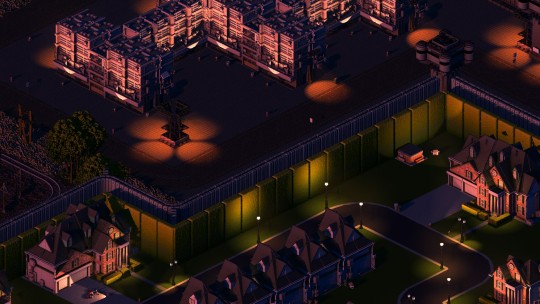
But apathetic architecture isn’t the same as thoughtless architecture. One of the clearest intents behind much of Solo Nobre’s urban planning is its concerted effort to distance the haves and the have-nots, coddling the former and shutting out the latter. Cramped slums frequently sit side-by-side with idyllic American Dream suburbs, divided by district walls—once again, we return to walls—that have been coated on one side with improbably tall hedges, so their viewers may entertain the fragment of an illusion that all is well in their slice of freshly-mowed Eden. Such proximity between the wealthy and the poor suggests that space is scarce on Solo Nobre, but not so scarce that the former can’t afford to have sweeping lawns and tacky, towering neoclassical McMansions. You could be forgiven for starting to wonder if something’s wrong with the scale, when your titanic walking weapons platform that could put a foot through a tower block suddenly has to crane its neck to shoot over a family home, but no—it’s just another way of illustrating the yawning gulf in privilege to your eye in the sky. One mission takes you out onto the green expanses of a country club, which—along with a sizeable occupying force, obviously—also features imposing gun turrets built into the landscape, poking out the top of more hedge-covered fortifications. Why would a golf course need such entrenched defensive measures, in what we’ve been led to believe was a relatively peaceful time? They can only have been a means of deterrence; of scaring away the riff-raff and making the privileged feel secure, without the excessive use of unsightly district checkpoints and barricades.
Yet even with this sweeping disparity, there’s a common thread in Solo Nobre of humanisation of oppressive spaces. Between hulking pipelines, paved concrete expanses and endless bleak industrial estates, there’s mounting evidence that Great Leader’s priorities were not the well-being of his workers, but here and there are tiny, isolated reminders that people still manage to engage in recreation. A single basketball hoop at the end of a loading dock, lined by rows of identical storage units; a children’s climbing frame in the middle of a muddy plot, ringed by skeletal steel pylons; a lone fifties-style diner, complete with a scattering of those cheap white plastic chairs, bleached by the halogen glow of a communications mast. They’re fragments of lives, not destined to be pieced together into a cohesive narrative, but to simply remind us that even in the city’s coldest, most utilitarian corners, people are not drones. Until now, we’ve focused on tales of communities and collectives, but to view people only in the plural like this is to risk treating them as so many trivial organisms under a microscope, always moving in tides, their individual impulses lost in the swarm. It’s details like these that keep us grounded, so to speak, even while gazing down at the sprawl.
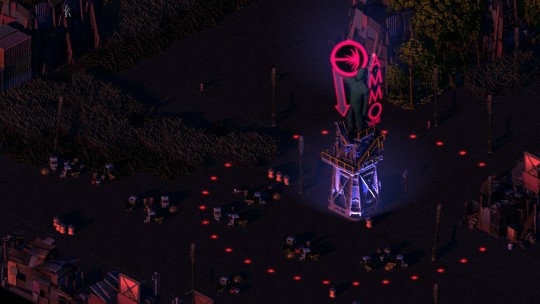
That’s all just history, though, innit? That’s stuff that happened over months, years, decades even. But some of the imprints on Brigador’s landscape are more temporal, left by events far more relevant to your current mission. Solo Nobre’s liberation takes place over a single night—or so it’s implied—and while you may be the first to fire a shot, you’re certainly not the first to make a move.
Traffic. It’s the traffic. You could initially be forgiven for thinking that the streets of Solo Nobre, despite their spaciousness and high standard of upkeep, don’t seem to be getting a lot of use; they’re utterly devoid of active civilian vehicles, trodden only by the assorted war machines of your opponents. Brigador doesn’t feature non-combatant units—other than the tiny raincoat-clad civilians who mill around helplessly until being crushed carelessly underfoot—but nevertheless, you’ll soon find remains of traffic jams around the maps: gridlocked, bumped-to-bumper, clearly long-since abandoned when it became apparent none of it was ever going to budge an inch further. Why would it be so tightly packed, and trail so far back, in a city where the highways are so wide that you could triple-park an interstellar freighter across one without making everyone late for work?

Once again, placement is the key. Brigador’s abandoned traffic isn’t randomly distributed, but concentrated around particular points. Lanes upon lanes of gently cooling automobiles are regularly found clustered in front of district checkpoints, around spaceports, even outside train depots, seemingly stopped in their tracks. A picture forms; a picture of a reeling state power rushing to regain its faculties, crack down on sudden unrest, minimize chaos. Of people hearing the news, sensing the forthcoming conflict, choking the roads with their attempts to flee. Of the two forces colliding in the lengthening shadows of a checkpoint, a cacophony of horns and furious shouts assaulting a grim military police barricade. Evacuation efforts scuppered. Deadlock. Until the Corvids turn up in their scrapyard siege engines and flatten a few city blocks, obviously.
But the exodus of Solo Nobre isn’t a complete failure. As your trail of destruction spirals out towards the edges of the colony, from the urban sprawl to its inevitable, oft-forgotten by-products, signs of relief begin to manifest. Nestled up against neglected pipelines and crumbling walls are clusters of blue tents—the kind of blue they only ever use on tarpaulins and concert port-a-potties—propped up with flimsy poles, dulled by the mud of the wastes. They’re ramshackle, disorganised, and frequently located in spots of dubious tactical importance, all of which suggest that while the materials might come from a Loyalist source, they’ve certainly not been set up under any kind of military coordination. Indeed, their most unifying quality seems to be that they’ve been pitched out of the way of populated zones—presumably by people who have had quite enough near misses with cluster mortar strikes for one night. These are camps set up by refugees, no way around it; people fleeing the power struggle, one way or another, trying to hole up somewhere so backwater that nobody would waste time fighting over it. Alas, as the presence of you and your enemies implies, they’re disastrously wrong. But that can’t be helped now, can it?

I suppose the only thing left to wonder is what, if anything, Brigador hopes to make us feel with all this effort. It leaves features on the landscape to tell us that these things happened, but despite our inarguable involvement, never ties those events back to us; never blames us for displacing innocent people, destroying their homes and gibbing them in the streets with careless cannon fire. In a game that encourages you to look at your environment in terms of little more than the cover it offers, it’s easy to tune out such ghastly side effects, particularly when the only feedback you get from razing civilian buildings to the ground is a miniscule bonus—yes, a bonus, perplexingly—to your end-of-level payout. No guilt, no joy, just a matter-of-fact occurrence. But as a mercenary, fighting first and foremost for a sodding huge cheque, perhaps it’s only appropriate that the only stimulus you get from needless destruction is an insignificant increment on your score counter. What better metaphor could there be for the faint flicker of acknowledgement, cold and distant as the shores of Titan, in a mind focused entirely on the task at hand?
It’s not easy, communicating using only the features that are visible to passing airliners, but Brigador plays to its strengths. It focuses on sweeping trends and dramatic shifts—which are, of course, common during times of unrest—using them to speak of the effects of dictatorial regime and violent power struggles, but scatters around visible one-off details too, as humanising fragments for those who stop and take notice. Nobody could ever describe it as an epic narrative tour-de-force, but I find it to be a fabulous example of working within limitations; of understanding how sociopolitical transformations can embed their effects in the landscape, and how we can read them back again—so long as they aren’t demolished by a Killdozer first, anyway.
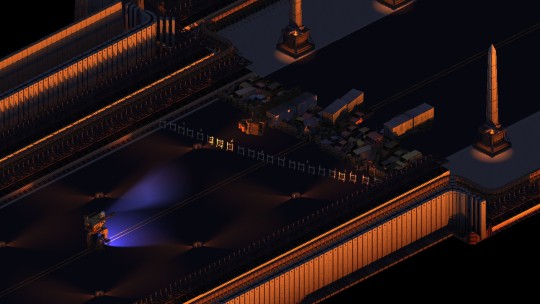
156 notes
·
View notes
Text
It’s easy to forget JRR Tolkien was a fairly prolific academic translator with an interest in early medieval literature and philology. It’s so inspiring that he found time to write The Hobbit while fighting for his life over Beowulf.
21K notes
·
View notes
Text
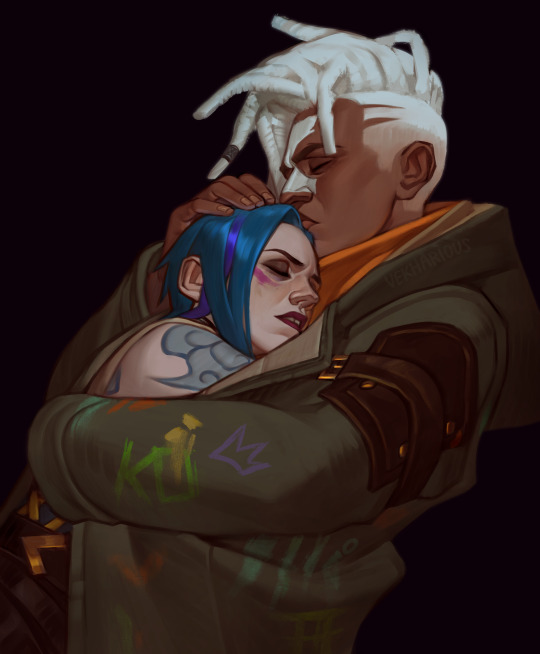
of all the people, I hoped it'd be you to come and free me, take me away to show me my home where I was born where I belong
50K notes
·
View notes
Text


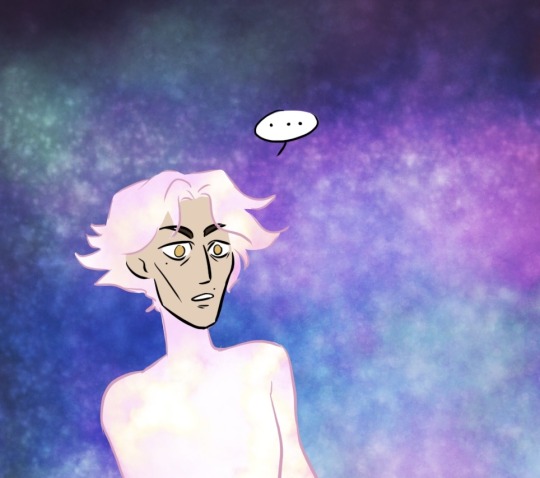

If your husband actually signs the divorce papers you gave him you might just need to start an apocalypse about it…
Divorce Era Jayvik, my beloved, my dearest…
56K notes
·
View notes
Text





poor Sevika's been embarrassed ever since, yet still stuck around😔✊
83K notes
·
View notes
Text
trans girl: i wish the world wasnt so cruel to me just for being my authentic self
genderfuck millenial with "fuck terfs" in bio: see THIS is why we need to be kinder to men & males. people are treating this person so bad for what? bc they're male? bc they seem masculine? trans men also face this too, and cis men tbh. the world is just so fucking cruel to masculine people. trans men's liberation now.
they/he ex terf mutual who still rbs from the "nice ones": the oppression people face when they present as afab is so real. afabs know what its like to be hurt like this. female socialisation makes the world so violent for us. like it cannot be overstated the kind of violence we face just for the way that we are born.
trans girl: you guys dont make me feel all that safe or understood actually
transandrobro who is actively participating in the harrassment campaign of 5 other women: i just fantasised about killing you
5K notes
·
View notes
Text
This series is single-handedly healing what the finale broke in me.

7K notes
·
View notes
Text
a while ago I read this sci-fi short story from the 50s where a guy is kidnapped and interrogated by aliens using a very sophisticated lie detector, but he realizes that the lie detector works off technical truth, and with some careful phrasing and misdirection, he manages to make them believe that humans are a race of immortal, overpowered, omniscient telepathic beings. and it works.
my favorite part is when he tells them that humans are "capable of transportation without the aid of spaceships or any vehicles, just by using mental power to control physical matter". it's true, we can. it's called walking.
55K notes
·
View notes
Text
No because what do you mean they were best friends as kids and Ekko had a crush on her, and then he tries to ‘rescue’ her from Silco but she doesn’t want to go with him and they end up on opposing sides as enemies and he insists that ‘Powder is gone, only Jinx is left’ but he paints a mural for Powder as one of the people they’ve lost and when he has the chance to kill her he can’t bring himself to do it because he still cares about her and she tries to blow them both up because she views death as mercy and wants to die with him and then he gets sent to another universe where she’s still Powder and he falls in love with her all over again and he goes back to his universe convinced he can save her and he has to watch her kill herself over and over again before managing to convince her to live and join the fight and they do and he wears her paint and then she just… dies anyways and now he’s lost her for like, the NINTH TIME
Arcane writers you will start coughing in 10 days
25K notes
·
View notes
Text
So the gift Powder received from Ekko was a necklace with a blue peony.
And you know me from my Vi and Caitlyn post so of course I'll look up what the flower language of that means and it's the following:


And if you look closely, you can see the profile faces of Ekko and Powder in between the petals

In this reality, the two can't be together, as he wasn't HER Ekko. But Powder still means the world to him.
25K notes
·
View notes
Text


oh sorry i wasn’t listening i was just thinking about how alternate powder’s hideout has rails because she actually values her life
[ID: Arcane screencaps of Jinx/Powder's hideouts; both are similar in layout, but Jinx's is more harshly and colorfully lit and does not feature guard rails. End ID]
38K notes
·
View notes
Text


The fact that Ekko went back in time god knows how many times again and again to get jinx to not kill herself only to end up losing her again makes me INSANE
31K notes
·
View notes

